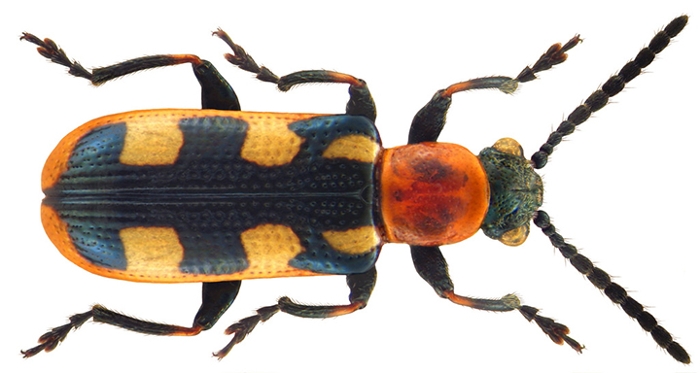
Asparagus beetle
Nuisance
The common asparagus beetle (Crioceris asparagi) pictured above, and the spotted asparagus beetle, (Crioceris duodecimpunctata) are pests of asparagus.
The common asparagus beetle is found more often in the Prairie asparagus patch and is also more destructive than the spotted asparagus beetle. Both beetles are approximately 0.5cm long with oval-shaped bodies and medium length antennae. Both beetle types have slug-like larvae with visible heads and legs. Common asparagus beetle larvae are light grey with a black head whereas spotted asparagus beetle larvae are orange.
The common asparagus beetle is bluish black in colour with 6 cream coloured spots on its back. The spotted asparagus beetle is reddish-orange with 12 black spots on its back. The spotted asparagus beetle should not be confused with beneficial ladybugs which are very similar in colour but are more rounded and dome-shaped than the spotted asparagus beetle. The spotted asparagus beetle prefers to eat asparagus berries and rarely causes damage to leaves and ferns.
Common asparagus beetle adults overwinter in sheltered locations, including the hollow stems of old asparagus plants. Adults will appear in the soil just as the spears are emerging from the soil in spring. These early emerging common asparagus beetles can feed on spears early in the season, causing browning and scarring on the spears as well as spears that bend over in a shepherd’s crook appearance shortly after emergence.
The adult beetles lay numerous dark brown, oval-shaped eggs in rows on spears or ferns. Within one week, the eggs hatch and larvae start feeding on ferns. After about two weeks, the larvae fall to the ground and pupate in the soil. About one week later, the adults emerge to start another generation and feed on ferns for the remainder of the growing season. Excessive feeding on the ferns can result in weakened crowns which will be more susceptible to Fusarium crown rot.
Control:
- Scout for asparagus beetles in early spring and hand pick. Dump them into a pail of soapy water. Monitor the patch regularly and continue to hand pick.
- Harvest asparagus spears by cutting to ground level daily in spring.
- Scout for clusters of light brown eggs of the common asparagus beetle on stems of asparagus spears in early spring. The spotted asparagus beetle lays orange eggs on the mature ferns later in summer.
- Natural predators of asparagus beetle include the common ladybug, Tetrastichus asparagi (a tiny, non-stinging metallic green wasp) and chalcid wasps.
- Never use insecticides in the garden, which also kill beneficial insects.
- Use mulch in the asparagus patch to create habitat for beneficials.
- It's important to allow the ferny foliage of asparagus to develop late in the season so that the plants can make food to put energy into the roots. This is the time to:
- Pick any berries off the foliage which is the preferred food of the spotted asparagus beetle.
- At the end of summer, cut the foliage to ground level to reduce overwintering sites.
- Shallow cultivate the patch in fall. This will bring the pupa to the surface of the soil where they will either be eaten by predator birds or freeze.
Sources:
Williams, S.; Skinner, H. (2011). Gardening, naturally: A chemical-free handbook for the Prairies. Regina, Saskatchewan: Coteau Books.
asparagus beetle ipm.edu (retrieved March 29, 2021)

